Increasing 3D Printing Accuracy Through Convolutional Neural Network-Based Compensation for Geometric Deviations
Abstract
1. Introduction
2. Proposed Method
- : Total deviation of part 1 (mm)
- : Systematic deviation inherent to the printing process (mm)
- : Random deviation specific to part 1 (mm)
- : Residual deviation after compensation (mm)
- : Systematic deviation inherent to the printing process (mm)
- : Random deviation of the compensated part (mm)
- : Total deviation of part 1 (mm)
- : Random deviation specific to part 1 (mm)
- : Average deviation of n parts (mm)
- n: Number of scanned parts (unitless)
- : Total deviation of part i (mm)
- : Systematic deviation inherent to the printing process (mm)
- : Random deviation of part i (mm)
- : Residual deviation of the compensated part using average deviation (mm)
- : Systematic deviation inherent to the printing process (mm)
- : Random deviation of the compensated part (mm)
- : Average deviation of n parts (mm)
- n: Number of scanned parts (unitless)
- : Random deviation of part i (mm)
2.1. Data Preprocessing
- : Position vector of the center of cell (mm)
- : Reference point (typically the center of the surface patch) (mm)
- : Unit vector perpendicular to the surface patch (unitless)
- : Unit vector in the orientation direction of the patch (unitless)
- D: Grid cell size (mm)
- : Number of cells per row and column in the grid (unitless)
- u, v: Indices of the cell in the grid array (unitless)
2.2. Compensation Convolutional Neural Network
- : Coordinate vector of the original vertex i on the reference geometry (mm)
- : Output of the compensation CNN for vertex i, representing the systematic deviation (mm)
- : Normal vector at vertex i on the reference geometry (unitless)
- : Coordinate vector of the compensated vertex i (mm)
3. Experimental Methodology
3.1. Reference Geometry
3.2. Dataset Collection
3.3. Data Preprocessing and Compensation CNN Training
- : Initial learning rate (unitless)
- : Current epoch number (unitless)
- : Learning rate at the current epoch (unitless)
3.4. Compensation CNN Evaluation
4. Results
4.1. Compensation CNN Training
4.2. Result of Compensation Using the Convolutional Neural Network
5. Discussion
6. Conclusions
Author Contributions
Funding
Data Availability Statement
Conflicts of Interest
Abbreviations
| AM | Additive Manufacturing |
| PPE | Personal Protective Equipment |
| FDM | Fused Deposition Modelling |
| FFF | Fused Filament Fabrication |
| SLA | Stereolithography Apparatus |
| CAD | Computer Aided Design |
| FEA | Finite Element Analysis |
| ICP | Iterative Closest Point |
| STL | Standard Tessellation Language |
| GD&T | Geometric Dimensioning and Tolerancing |
| CMM | Coordinate Measuring Machine |
References
- Sachs, E.; Cima, M.; Williams, P.; Brancazio, D.; Cornie, J. Three dimensional printing: Rapid tooling and prototypes directly from a CAD model. J. Eng. Ind. 1992, 114, 481–488. [Google Scholar] [CrossRef]
- Campbell, I.; Bourell, D.; Gibson, I. Additive manufacturing: Rapid prototyping comes of age. Rapid Prototyp. J. 2012, 18, 255–258. [Google Scholar] [CrossRef]
- Colosimo, B.M.; Huang, Q.; Dasgupta, T.; Tsung, F. Opportunities and challenges of quality engineering for additive manufacturing. J. Qual. Technol. 2018, 50, 233–252. [Google Scholar] [CrossRef]
- Mehrpouya, M.; Dehghanghadikolaei, A.; Fotovvati, B.; Vosooghnia, A.; Emamian, S.S.; Gisario, A. The potential of additive manufacturing in the smart factory industrial 4.0: A review. Appl. Sci. 2019, 9, 3865. [Google Scholar] [CrossRef]
- Ye, Z.; Liu, C.; Tian, W.; Kan, C. A deep learning approach for the identification of small process shifts in additive manufacturing using 3D point clouds. Procedia Manuf. 2020, 48, 770–775. [Google Scholar] [CrossRef]
- Tamir, T.S.; Xiong, G.; Fang, Q.; Yang, Y.; Shen, Z.; Zhou, M.; Jiang, J. Machine-learning-based monitoring and optimization of processing parameters in 3D printing. Int. J. Comput. Integr. Manuf. 2022, 36, 1362–1378. [Google Scholar] [CrossRef]
- Brion, D.A.; Pattinson, S.W. Generalisable 3D printing error detection and correction via multi-head neural networks. Nat. Commun. 2022, 13, 4654. [Google Scholar] [CrossRef]
- Chacón, J.; Caminero, M.A.; García-Plaza, E.; Núnez, P.J. Additive manufacturing of PLA structures using fused deposition modelling: Effect of process parameters on mechanical properties and their optimal selection. Mater. Des. 2017, 124, 143–157. [Google Scholar] [CrossRef]
- Liu, S.; Zhao, P.; Wu, S.; Zhang, C.; Fu, J.; Chen, Z. A pellet 3D printer: Device design and process parameters optimization. Adv. Polym. Technol. 2019, 2019, 1–8. [Google Scholar] [CrossRef]
- Elkaseer, A.; Schneider, S.; Scholz, S.G. Experiment-based process modeling and optimization for high-quality and resource-efficient FFF 3D printing. Appl. Sci. 2020, 10, 2899. [Google Scholar] [CrossRef]
- Deswal, S.; Narang, R.; Chhabra, D. Modeling and parametric optimization of FDM 3D printing process using hybrid techniques for enhancing dimensional preciseness. Int. J. Interact. Des. Manuf. (IJIDeM) 2019, 13, 1197–1214. [Google Scholar] [CrossRef]
- Nath, P.; Olson, J.D.; Mahadevan, S.; Lee, Y.T.T. Optimization of fused filament fabrication process parameters under uncertainty to maximize part geometry accuracy. Addit. Manuf. 2020, 35, 101331. [Google Scholar] [CrossRef]
- Sarraga, R.F. Modifying CAD/CAM surfaces according to displacements prescribed at a finite set of points. Comput.-Aided Des. 2004, 36, 343–349. [Google Scholar] [CrossRef]
- Chowdhury, S.; Mhapsekar, K.; Anand, S. Part Build Orientation Optimization and Neural Network-Based Geometry Compensation for Additive Manufacturing Process. J. Manuf. Sci. Eng. 2018, 140, 31009. [Google Scholar] [CrossRef]
- Chowdhury, S.; Anand, S. Artificial neural network based geometric compensation for thermal deformation in additive manufacturing processes. In Proceedings of the International Manufacturing Science and Engineering Conference, Blacksburg, VA, USA, 27 June–1 July 2016; Volume 49910, p. V003T08A006. [Google Scholar]
- Francis, J.; Bian, L. Deep Learning for Distortion Prediction in Laser-Based Additive Manufacturing using Big Data. Manuf. Lett. 2019, 20, 10–14. [Google Scholar] [CrossRef]
- Huang, Y.; Wang, T.; Li, W.; Xu, Y.; Ji, H.; Zhang, H.; Liu, H.; Yang, Y. Geometric compensation of sintering deformation in binder jetting additive manufacturing based on artificial neural network. Prog. Addit. Manuf. 2024, 1–17. [Google Scholar] [CrossRef]
- Tong, K.; Amine Lehtihet, E.; Joshi, S. Parametric error modeling and software error compensation for rapid prototyping. Rapid Prototyp. J. 2003, 9, 301–313. [Google Scholar] [CrossRef]
- Huang, Q.; Nouri, H.; Xu, K.; Chen, Y.; Sosina, S.; Dasgupta, T. Statistical Predictive Modeling and Compensation of Geometric Deviations of Three-Dimensional Printed Products. J. Manuf. Sci. Eng. 2014, 136, 61008. [Google Scholar] [CrossRef]
- Shah, P.; Racasan, R.; Bills, P. Comparison of different additive manufacturing methods using computed tomography. Case Stud. Nondestruct. Test. Eval. 2016, 6, 69–78. [Google Scholar] [CrossRef]
- Wang, A.; Song, S.; Huang, Q.; Tsung, F. In-Plane Shape-Deviation Modeling and Compensation for Fused Deposition Modeling Processes. IEEE Trans. Autom. Sci. Eng. 2017, 14, 968–976. [Google Scholar] [CrossRef]
- Cressie, N. Spatial prediction and ordinary kriging. Math. Geol. 1988, 20, 405–421. [Google Scholar] [CrossRef]
- Cheng, L.; Wang, A.; Tsung, F. A prediction and compensation scheme for in-plane shape deviation of additive manufacturing with information on process parameters. IISE Trans. 2018, 50, 394–406. [Google Scholar] [CrossRef]
- Huang, Q. An Analytical Foundation for Optimal Compensation of Three-Dimensional Shape Deformation in Additive Manufacturing. J. Manuf. Sci. Eng. 2016, 138, 061010. [Google Scholar] [CrossRef]
- Luan, H.; Huang, Q. Prescriptive Modeling and Compensation of In-Plane Shape Deformation for 3D Printed Freeform Products. IEEE Trans. Autom. Sci. Eng. 2017, 14, 73–82. [Google Scholar] [CrossRef]
- Huang, Q.; Wang, Y.; Lyu, M.; Lin, W. Shape Deviation Generator—A Convolution Framework for Learning and Predicting 3D Printing Shape Accuracy. IEEE Trans. Autom. Sci. Eng. 2020, 17, 1486–1500. [Google Scholar] [CrossRef]
- Wang, Y.; Ruiz, C.; Huang, Q. Learning and Predicting Shape Deviations of Smooth and Non-Smooth 3D Geometries Through Mathematical Decomposition of Additive Manufacturing. IEEE Trans. Autom. Sci. Eng. 2023, 20, 1527–1538. [Google Scholar] [CrossRef]
- Sabbaghi, A.; Huang, Q.; Dasgupta, T. Bayesian model building from small samples of disparate data for capturing in-plane deviation in additive manufacturing. Technometrics 2018, 60, 532–544. [Google Scholar] [CrossRef]
- Sabbaghi, A.; Huang, Q. Model transfer across additive manufacturing processes via mean effect equivalence of lurking variables. Ann. Appl. Stat. 2018, 12, 2409–2429. [Google Scholar] [CrossRef]
- Tsung, F.; Zhang, K.; Cheng, L.; Song, Z. Statistical transfer learning: A review and some extensions to statistical process control. Qual. Eng. 2018, 30, 115–128. [Google Scholar] [CrossRef]
- Ferreira, R.d.S.B.; Sabbaghi, A.; Huang, Q. Automated geometric shape deviation modeling for additive manufacturing systems via Bayesian neural networks. IEEE Trans. Autom. Sci. Eng. 2019, 17, 584–598. [Google Scholar] [CrossRef]
- Tao, C.; Du, J.; Chang, T.S. Anomaly detection for fabricated artifact by using unstructured 3D point cloud data. IISE Trans. 2023, 55, 1174–1186. [Google Scholar] [CrossRef]
- Huang, Q. An impulse response formulation for small-sample learning and control of additive manufacturing quality. IISE Trans. 2022, 55, 926–939. [Google Scholar] [CrossRef]
- Khanzadeh, M.; Rao, P.; Jafari-Marandi, R.; Smith, B.K.; Tschopp, M.A.; Bian, L. Quantifying geometric accuracy with unsupervised machine learning: Using self-organizing map on fused filament fabrication additive manufacturing parts. J. Manuf. Sci. Eng. 2018, 140, 31011. [Google Scholar] [CrossRef]
- Decker, N.; Lyu, M.; Wang, Y.; Huang, Q. Geometric Accuracy Prediction and Improvement for Additive Manufacturing Using Triangular Mesh Shape Data. J. Manuf. Sci. Eng. 2021, 143, 61006. [Google Scholar] [CrossRef]
- Breiman, L. Random Forests. Mach. Learn. 2001, 45, 5–32. [Google Scholar] [CrossRef]
- Zhu, Z.; Ferreira, K.; Anwer, N.; Mathieu, L.; Guo, K.; Qiao, L. Convolutional Neural Network for geometric deviation prediction in Additive Manufacturing. Procedia CIRP 2020, 91, 534–539. [Google Scholar] [CrossRef]
- Li, L.; McGuan, R.; Isaac, R.; Kavehpour, P.; Candler, R. Improving precision of material extrusion 3D printing by in-situ monitoring & predicting 3D geometric deviation using conditional adversarial networks. Addit. Manuf. 2021, 38, 101695. [Google Scholar] [CrossRef]
- McGregor, D.J.; Bimrose, M.V.; Shao, C.; Tawfick, S.; King, W.P. Using machine learning to predict dimensions and qualify diverse part designs across multiple additive machines and materials. Addit. Manuf. 2022, 55, 102848. [Google Scholar] [CrossRef]
- Mehta, P.; Mujawar, M.A.; Lafrance, S.; Bernadin, S.; Ewing, D.; Bhansali, S. Editors’ Choice—Review—Sensor-Based and Computational Methods for Error Detection and Correction in 3D Printing. ECS Sensors Plus 2024, 3, 030602. [Google Scholar] [CrossRef]
- Abdolahi, A.; Soroush, H.; Khodaygan, S. Process capability analysis of additive manufacturing process: A machine learning- based predictive model. Rapid Prototyp. J. 2025, 31, 724–741. [Google Scholar] [CrossRef]
- Zhao, M.; Xiong, G.; Wang, W.; Fang, Q.; Shen, Z.; Wan, L.; Zhu, F. A Point-Based Neural Network for Real-Scenario Deformation Prediction in Additive Manufacturing. In Proceedings of the 2022 IEEE 18th International Conference on Automation Science and Engineering (CASE), Mexico City, Mexico, 20–24 August 2022; pp. 1656–1661. [Google Scholar] [CrossRef]
- Hopfield, J.J. Artificial neural networks. IEEE Circuits Devices Mag. 1988, 4, 3–10. [Google Scholar] [CrossRef]
- Krizhevsky, A.; Sutskever, I.; Hinton, G.E. Imagenet classification with deep convolutional neural networks. Commun. ACM 2017, 60, 84–90. [Google Scholar] [CrossRef]
- Pu, Y.; Gan, Z.; Henao, R.; Yuan, X.; Li, C.; Stevens, A.; Carin, L. Variational autoencoder for deep learning of images, labels and captions. Adv. Neural Inf. Process. Syst. 2016, 29, 2360–2368. [Google Scholar]
- Alzubaidi, L.; Zhang, J.; Humaidi, A.J.; Al-Dujaili, A.; Duan, Y.; Al-Shamma, O.; Santamaría, J.; Fadhel, M.A.; Al-Amidie, M.; Farhan, L. Review of deep learning: Concepts, CNN architectures, challenges, applications, future directions. J. Big Data 2021, 8, 53. [Google Scholar] [CrossRef]
- Lecun, Y.; Bottou, L.; Bengio, Y.; Haffner, P. Gradient-based learning applied to document recognition. Proc. IEEE 1998, 86, 2278–2324. [Google Scholar] [CrossRef]
- Geirhos, R.; Temme, C.R.; Rauber, J.; Schütt, H.H.; Bethge, M.; Wichmann, F.A. Generalisation in humans and deep neural networks. Adv. Neural Inf. Process. Syst. 2018, 31, 7549–7561. [Google Scholar]
- Garcia-Garcia, A.; Gomez-Donoso, F.; Garcia-Rodriguez, J.; Orts-Escolano, S.; Cazorla, M.; Azorin-Lopez, J. Pointnet: A 3D convolutional neural network for real-time object class recognition. In Proceedings of the 2016 International Joint Conference on Neural Networks (IJCNN), Vancouver, BC, Canada, 24–29 July 2016; pp. 1578–1584. [Google Scholar]
- Hanocka, R.; Hertz, A.; Fish, N.; Giryes, R.; Fleishman, S.; Cohen-Or, D. Meshcnn: A network with an edge. ACM Trans. Graph. (TOG) 2019, 38, 1–12. [Google Scholar] [CrossRef]
- Qi, C.R.; Yi, L.; Su, H.; Guibas, L.J. Pointnet++: Deep hierarchical feature learning on point sets in a metric space. Adv. Neural Inf. Process. Syst. 2017, 30, 5105–5114. [Google Scholar]
- Song, S.; Lichtenberg, S.P.; Xiao, J. Sun rgb-d: A rgb-d scene understanding benchmark suite. In Proceedings of the IEEE Conference on Computer Vision and Pattern Recognition, Boston, MA, USA, 7–12 June 2015; pp. 567–576. [Google Scholar]
- Tan, Q.; Gao, L.; Lai, Y.K.; Xia, S. Variational autoencoders for deforming 3D mesh models. In Proceedings of the IEEE Conference on Computer Vision and Pattern Recognition, Salt Lake City, UT, USA, 18–23 June 2018; pp. 5841–5850. [Google Scholar]
- Jadayel, M.; Khameneifar, F. Improving Geometric Accuracy of 3D Printed Parts Using 3D Metrology Feedback and Mesh Morphing. J. Manuf. Mater. Process. 2020, 4, 112. [Google Scholar] [CrossRef]
- Bentley, J.L. Multidimensional binary search trees used for associative searching. Commun. ACM 1975, 18, 509–517. [Google Scholar] [CrossRef]
- Simonyan, K.; Zisserman, A. Very Deep Convolutional Networks for Large-Scale Image Recognition. arXiv 2015, arXiv:1409.1556. [Google Scholar]
- He, K.; Zhang, X.; Ren, S.; Sun, J. Deep Residual Learning for Image Recognition. arXiv 2015, arXiv:1512.03385. [Google Scholar]
- GOM. GOM Acceptance Test, Certificate No. 110826_CP20-170-60086. Acceptance/Reverification Base on VDI/VDE 2634, Part 3. Available online: https://www.zebicon.com/fileadmin/user_upload/2_Maaleudstyr/9_Certifikater/ATOS_Core_200_SN160300/2019-04-02_Acceptance_test_ATOS_Core_MV200_SN160300.pdf (accessed on 12 November 2020).
- Dawson-Haggerty. Trimesh, 2019. Available online: https://trimesh.org/ (accessed on 20 March 2022).
- Jacobson, A.; Panozzo, D. Libigl: A Simple C++ Geometry Processing Library. 2018. Available online: https://libigl.github.io/ (accessed on 17 September 2022).
- Paszke, A.; Gross, S.; Massa, F.; Lerer, A.; Bradbury, J.; Chanan, G.; Killeen, T.; Lin, Z.; Gimelshein, N.; Antiga, L.; et al. PyTorch: An Imperative Style, High-Performance Deep Learning Library. In Advances in Neural Information Processing Systems 32; Curran Associates, Inc.: San Francisco, CA, USA, 2019; pp. 8024–8035. [Google Scholar]
- Rumelhart, D.E.; Hinton, G.E.; Williams, R.J. Learning representations by back-propagating errors. Nature 1986, 323, 533–536. [Google Scholar] [CrossRef]
- Wang, Q.; Ma, Y.; Zhao, K.; Tian, Y. A Comprehensive Survey of Loss Functions in Machine Learning. Ann. Data Sci. 2022, 9, 187–212. [Google Scholar] [CrossRef]
- Srivastava, N.; Hinton, G.; Krizhevsky, A.; Sutskever, I.; Salakhutdinov, R. Dropout: A simple way to prevent neural networks from overfitting. J. Mach. Learn. Res. 2014, 15, 1929–1958. [Google Scholar]
- Biewald, L. Experiment Tracking with Weights and Biases. 2020. Available online: https://wandb.ai/site (accessed on 20 March 2022).
- Kingma, D.P.; Ba, J. Adam: A method for stochastic optimization. arXiv 2014, arXiv:1412.6980. [Google Scholar]
- Darken, C.; Chang, J.; Moody, J. Learning rate schedules for faster stochastic gradient search. In Proceedings of the Neural Networks for Signal Processing II Proceedings of the 1992 IEEE Workshop, Helsingoer, Denmark, 31 August–2 September 1992; pp. 3–12. [Google Scholar] [CrossRef]
- Zhang, C.; Bengio, S.; Hardt, M.; Recht, B.; Vinyals, O. Understanding deep learning requires rethinking generalization. arXiv 2017, arXiv:1611.03530. [Google Scholar] [CrossRef]
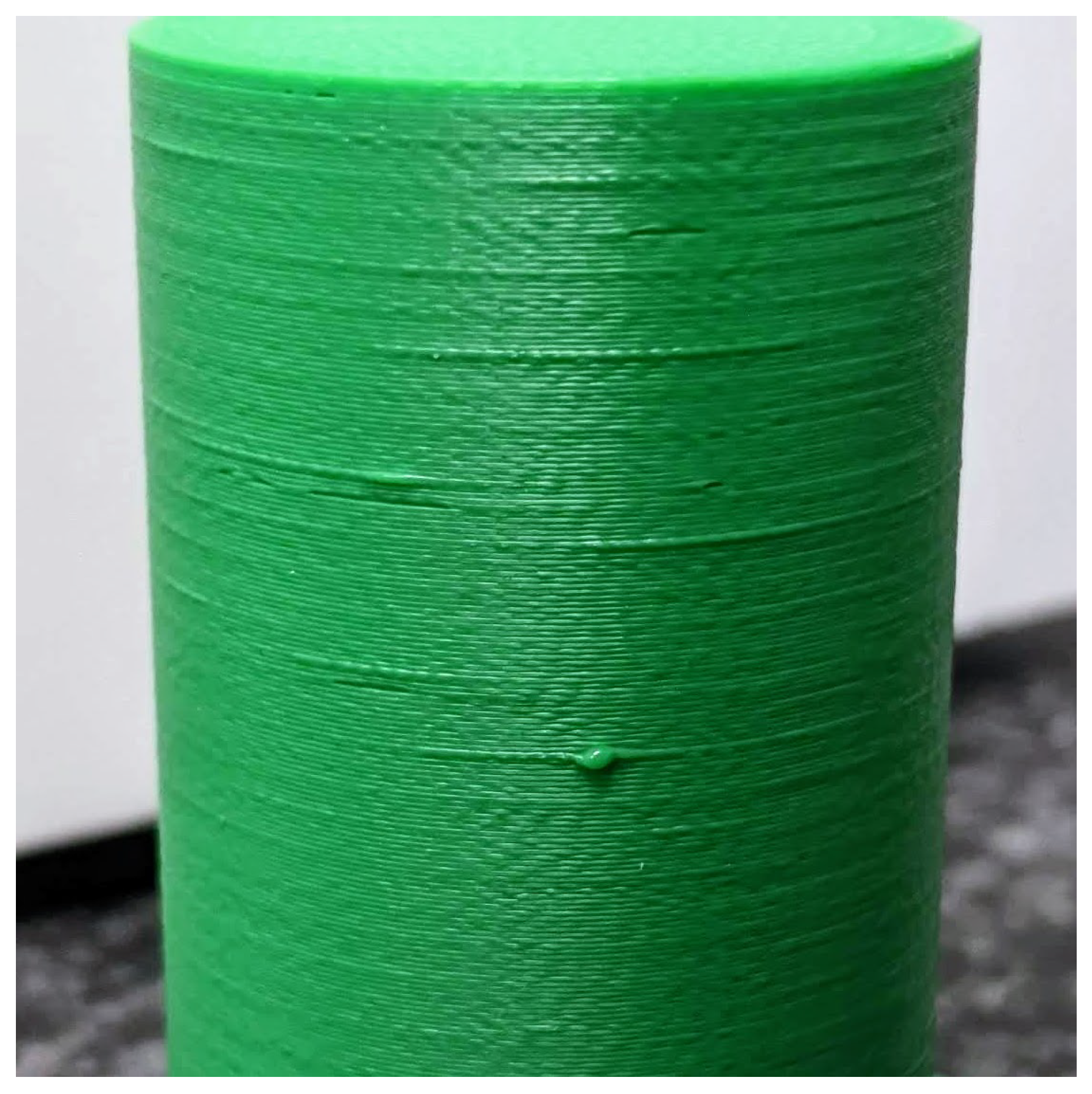




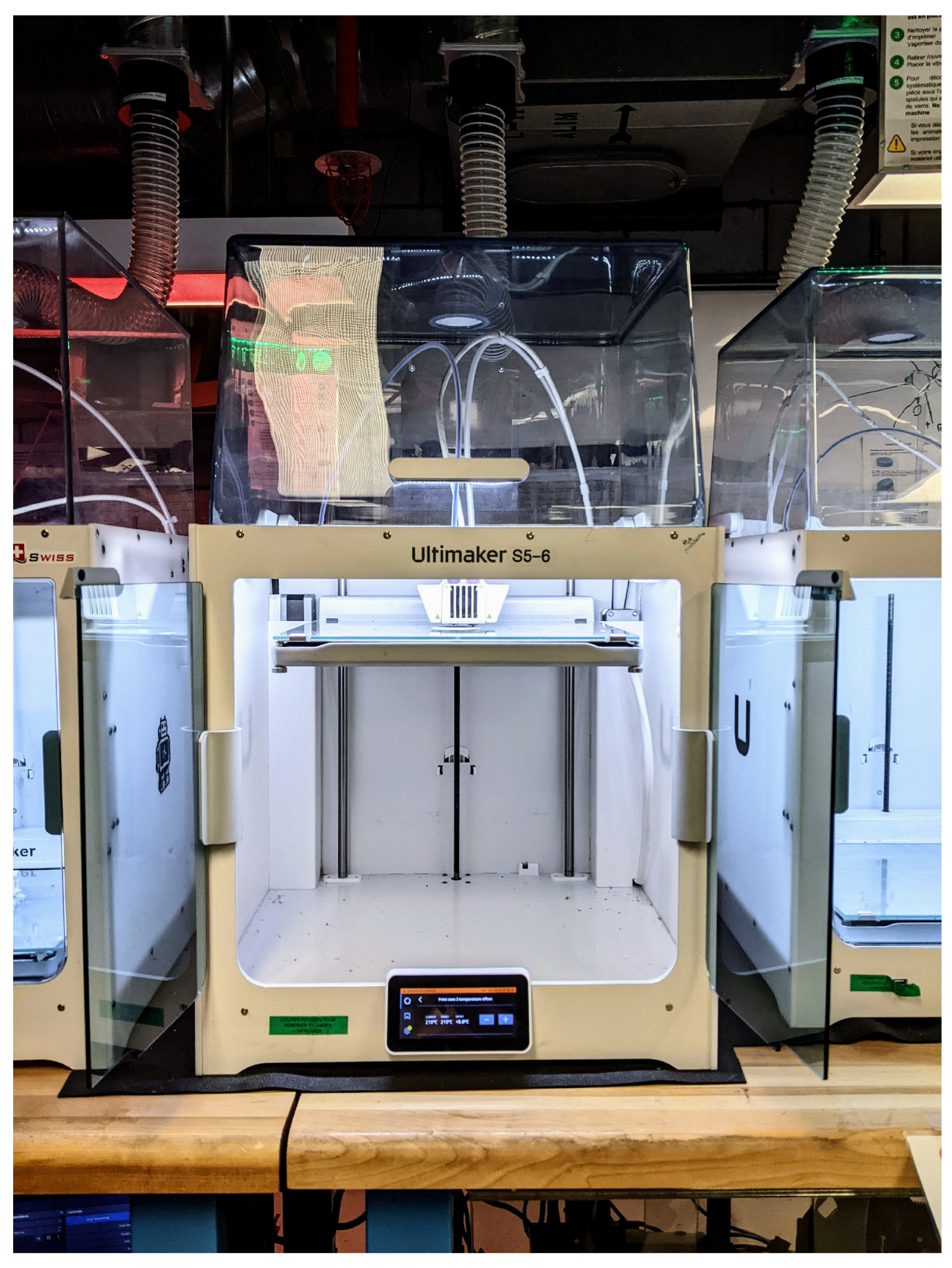
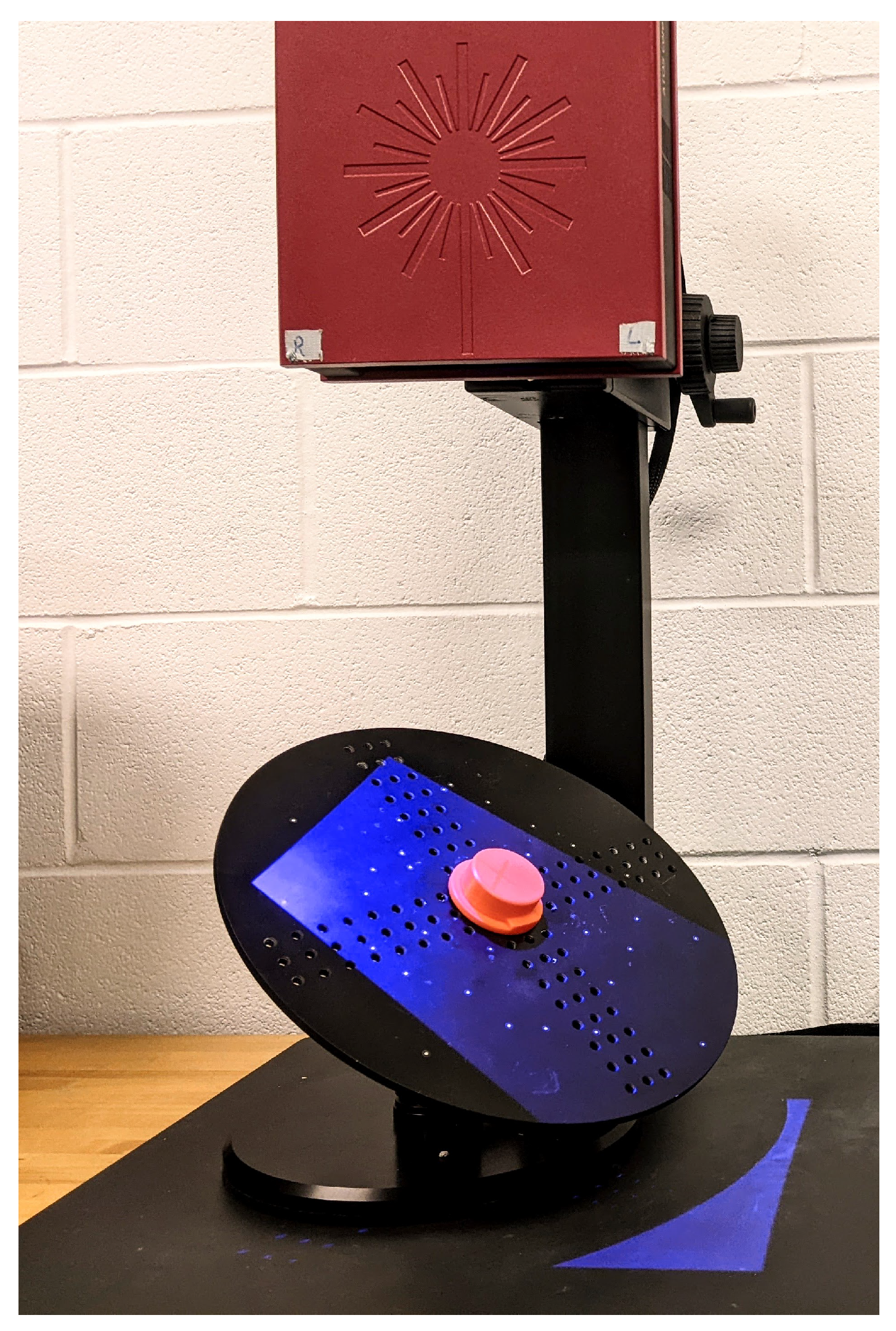
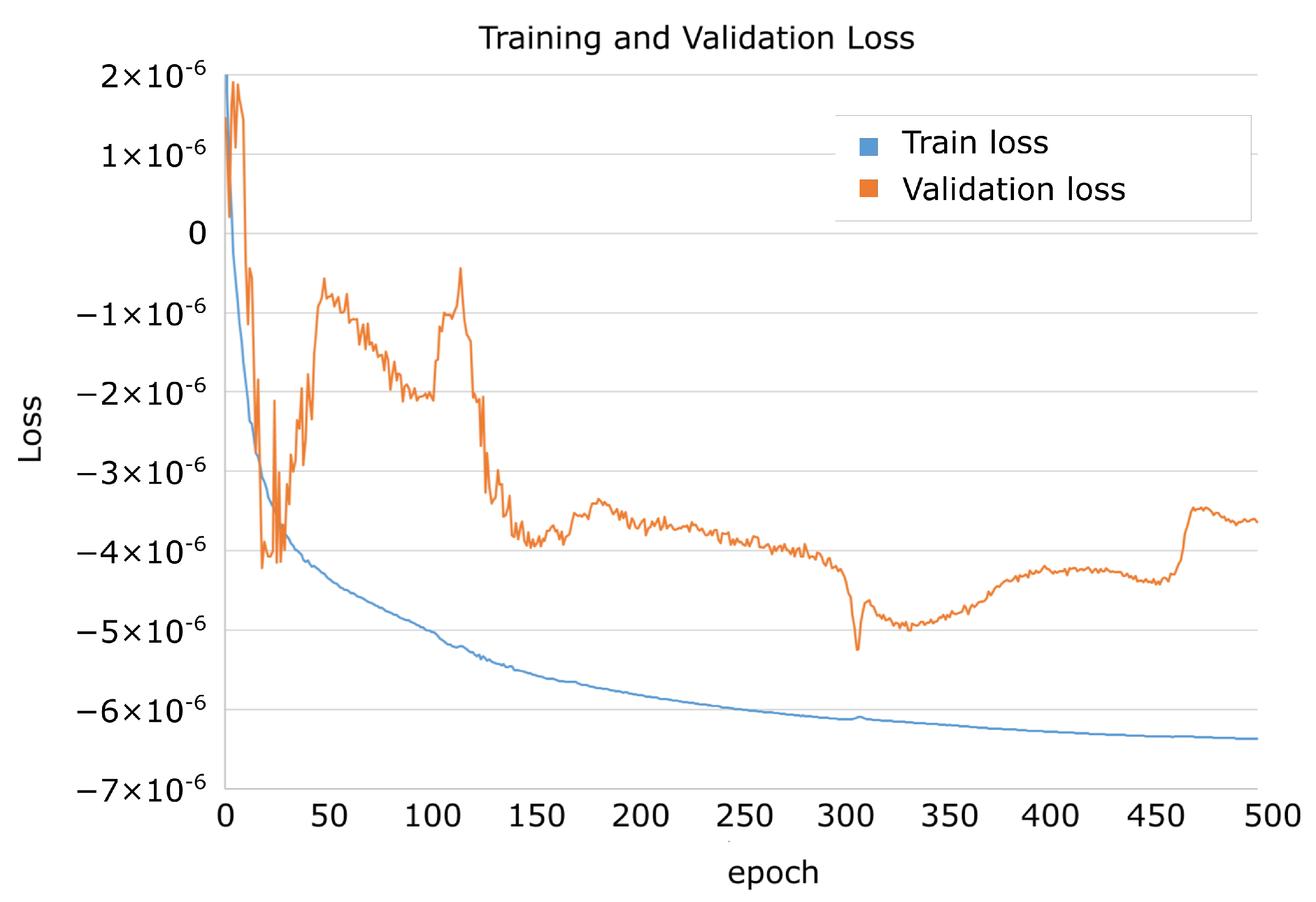
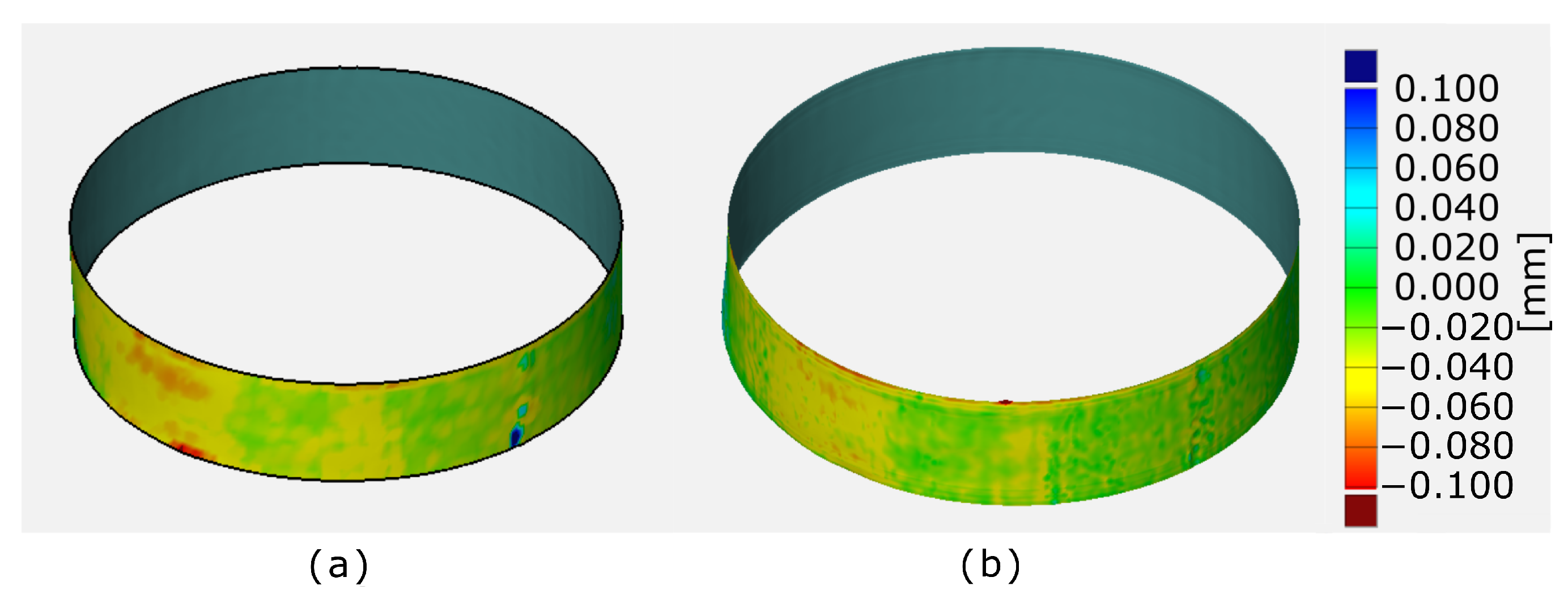

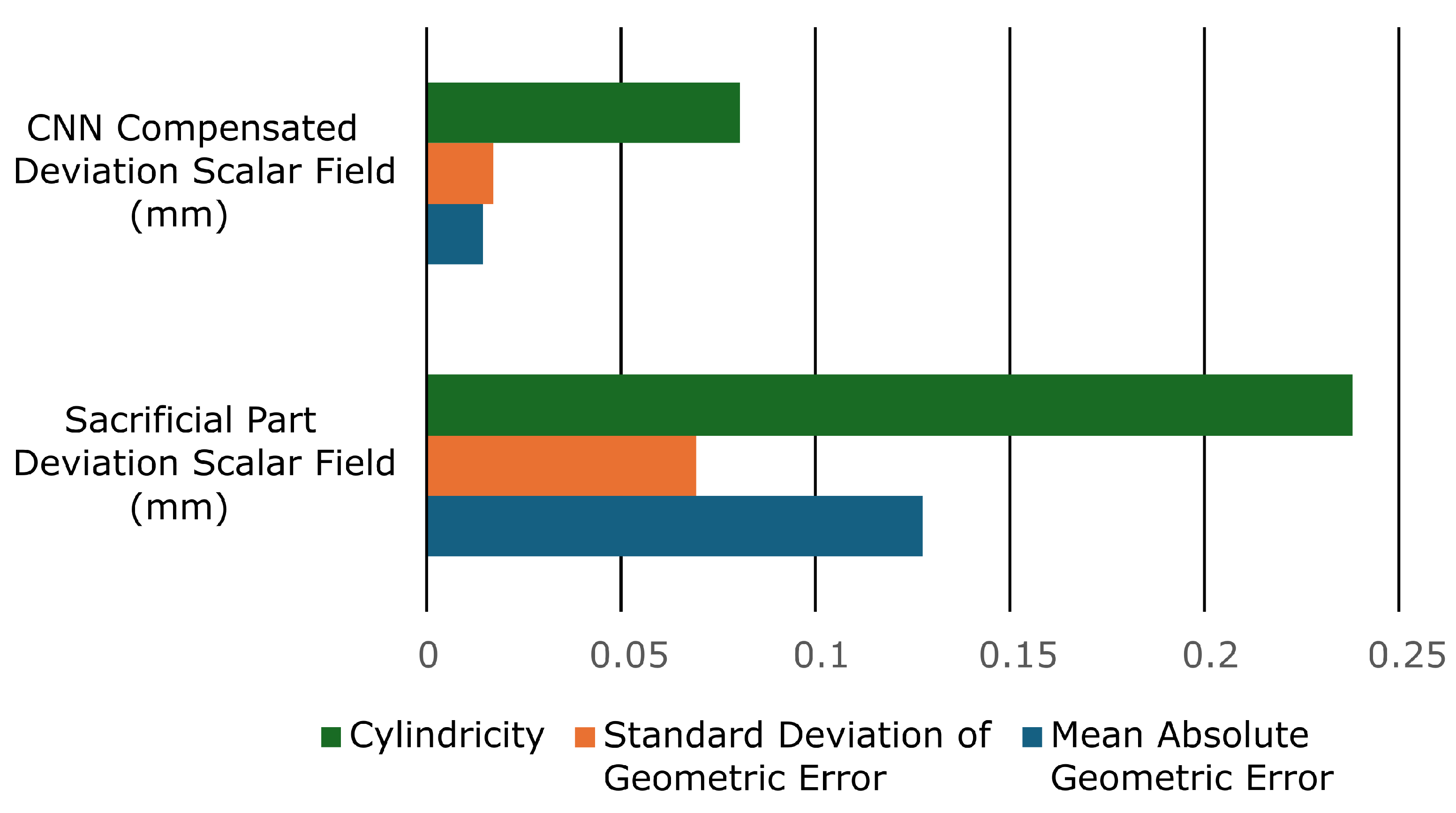
| Printing temperature | 215 °C |
| Printing speed | 70 mm/s |
| Cooling | 100% |
| Support | None |
| Infill type | Triangles |
| Infill density | 10% |
| Plate adhesion | None |
| Layer height | 0.2 mm |
| Nozzle diameter | 0.4 mm |
Disclaimer/Publisher’s Note: The statements, opinions and data contained in all publications are solely those of the individual author(s) and contributor(s) and not of MDPI and/or the editor(s). MDPI and/or the editor(s) disclaim responsibility for any injury to people or property resulting from any ideas, methods, instructions or products referred to in the content. |
© 2025 by the authors. Licensee MDPI, Basel, Switzerland. This article is an open access article distributed under the terms and conditions of the Creative Commons Attribution (CC BY) license (https://creativecommons.org/licenses/by/4.0/).
Share and Cite
Jadayel, M.; Khameneifar, F. Increasing 3D Printing Accuracy Through Convolutional Neural Network-Based Compensation for Geometric Deviations. Machines 2025, 13, 382. https://doi.org/10.3390/machines13050382
Jadayel M, Khameneifar F. Increasing 3D Printing Accuracy Through Convolutional Neural Network-Based Compensation for Geometric Deviations. Machines. 2025; 13(5):382. https://doi.org/10.3390/machines13050382
Chicago/Turabian StyleJadayel, Moustapha, and Farbod Khameneifar. 2025. "Increasing 3D Printing Accuracy Through Convolutional Neural Network-Based Compensation for Geometric Deviations" Machines 13, no. 5: 382. https://doi.org/10.3390/machines13050382
APA StyleJadayel, M., & Khameneifar, F. (2025). Increasing 3D Printing Accuracy Through Convolutional Neural Network-Based Compensation for Geometric Deviations. Machines, 13(5), 382. https://doi.org/10.3390/machines13050382










